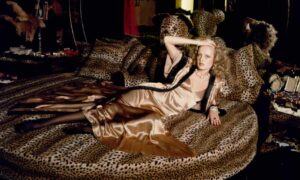
Long before millennial pink walls and neon slogan signs filled people’s lives, there was Biba, one of the world’s first lifestyle brands. Now, 49 years after the legendary emporium shut its doors for the final time, the Fashion & Textile Museum in London is paying homage with a new retrospective, The Biba Story, 1964-1975.
The brainchild of Barbara Hulanicki and her husband, Stephen Fitz-Simon, it evolved from selling clothing via mail order to offering everything from Biba-branded makeup to pet food and tins of baked beans from the sprawling seven-storey art deco building it occupied on Kensington High Street from 1973 until 1975.
Filled with antique ornate furniture, the clothes for sale were tossed on coat stands and surrounded by dimly lit feathered chandeliers. A Mistress room sold underwear and silk sheets, the restaurant/nightclub Rainbow room featured a ceiling lit with the colours of the rainbow, and on the rooftop shoppers could sip tea next to pink flamingos perched by a pond. On Saturdays, the queue curved its way along the high street, with customers ranging from teenagers to the Rolling Stones and Twiggy.
Curated by Martin Pel, the aim of the exhibition is, he says, to capture “just how fabulous Biba was”. Much of that fabulousness stems from Hulanicki. Born in Poland in 1936, she grew up in Palestine before moving aged 12 to England to live with her aunt after her diplomat father was assassinated. Now aged 87, she resides in Miami but has returned to London for the opening.
Many of the hundreds of pieces on display have come from the attics of former “Biba girls”, including Hulanicki’s first shop manager. Items range from a leopard-print coat designed for Twiggy in 1973 to devoré wrap dresses, and Hulanicki remembers sketching every single piece.
A short pink gingham shift dress based loosely on the one Brigitte Bardot wore in Saint-Tropez in 1963 opens the show. It is the dress that changed the course of Hulanicki’s life, pivoting the mail order fashion business she had co-founded with Fitz-Simon into the spotlight fafter its appearance in a fashion spread in the Mirror newspaper. On the same day, 17,000 readers placed orders.
